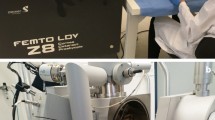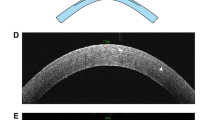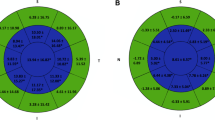Abstract
Background
To determine the surface characteristics of human corneal lenticules after femtosecond laser surgery for myopia.
Methods
The Carl Zeiss Meditec AG VisuMax® femtosecond laser system was used for refractive correction called Femtosecond Lenticule Extraction on 24 myopic eyes. The surface regularity on the refractive corneal lenticules recovered was evaluated by assessing scanning electron microscopy images using an established scoring system. Three different energy levels 150, 180, and 195 nJ were compared (n = 8 in each group).
Results
Surface irregularities were caused by tissue bridges, cavitation bubbles, or scratches. The surface regularity index (R2 = 0.74) decreased as pulse energy increased. The average surface regularity score obtained was 7.5 for 150 nJ, 7.25 for 180 nJ, and 6.25 for 195 nJ.
Conclusions
The human corneal lenticules created with the VisuMax® femtosecond laser system are of predictable, good-quality surface. This study shows the influence of pulse energy on surface regularity in human eyes. Further studies should focus on optimization of laser parameters as well as surgical technique to improve the regularity of the corneal stromal bed and so make the advantages of the femtosecond laser technology over conventional techniques clearer in the future.



Similar content being viewed by others
Abbreviations
- Avg.:
-
Average
- a.u.:
-
Arbitrary unit
- DLK:
-
Diffuse lamellar keratitis
- FLEx:
-
Femtosecond Lenticule Extraction
- h:
-
Hour
- kHz:
-
Kilohertz
- LASIK:
-
Laser in situ keratomileusis
- n:
-
Number of specimens
- nJ:
-
Nanojoule
- R2 :
-
Correlation coefficient
- SD:
-
Standard deviation
- SEM:
-
Scanning electron microscopy
- TLSS:
-
Transient light sensitivity syndrome
- μm:
-
Micrometer
References
Sekundo W, Kunert KS, Russmann C, Gille A, Bissmann W, Strobrawa G, Sticker M, Bischoff M, Blum M (2008) First efficacy and safety study of femtosecond lenticule extraction for the correction of myopia. J Cataract Refract Surg 34:1513–1520, Erratum in: J Cataract Refract Surg 34:1819
Blum M, Kunert K, Schroeder M, Sekundo W (2010) Femtosecond Lenticule Extraction (FLEx) for the correction of myopia: Preliminary 6 months results. Graefes Arch Clin Exp Ophthalmol. doi:10.1007/s00417-009-1293-1
Shah R (2009) Changing paradigm in refractive surgery. Advanced FLEx results. Presented at the Annual Symposium of the ASCRS, San Francisco, 2nd of April
Sarayba MA, Ignacio TS, Tran DB, Binder PS (2007) A 60 kHz IntraLase femtosecond laser creates a smoother LASIK stromal bed surface compared to a Zyoptix XP mechanical microkeratome in human donor eyes. J Refract Surg 23:331–337
Kermani O, Oberheide U (2008) Comparative micromorphologic in vitro porcine study of IntaLase and Femto LDV femtosecond lasers. J Cataract Refract Surg 34:1393–1399
Wilhelm FW, Giessmann T, Hanschke R, Duncker GIW, Wilhelm LH (2000) Cut edges and surface characteristics produced by different microkeratomes. J Refract Surg 16:690–700
Lubatschowski H (2008) Overview of commercially available femtosecond lasers in refractive surgery. J Refract Surg 24:102–107
Sarayba MA, Ignacio TS, Binder PS, Tran DB (2007) Comparative study of stromal bed quality by using mechanical, IntraLase femtosecond laser 15- and 30-kHz microkeratomes. Cornea 26:446–451
Winkler von Mohrenfels C, Khoramnia R, Maier MM, Pfäffl W, Hölzlwimmer G, Lohmann C (2009) Cut quality of a new femtosecond laser system. Klin Monatsbl Augenheilkd 226:470–474
Binder PS (2004) Flap dimensions created with the IntraLase FS laser. J Cataract Refract Surg 30:26–32
Holzer MP, Rabsilber TM, Auffarth GU (2006) Femtosecond laser-assisted corneal flap cuts: morphology, accuracy, and histopathology. Invest Ophthalmol Vis Sci 47:2828–2831
Heichel J, Hammer T, Sietmann R, Duncker GIW, Wilhelm F (2010) Rasterelektronenmikroskopischer Vergleich lamellärer Keratotomien nach Einsatz des Femtec Femtosekundenlasers und des Zyoptix XP Mikrokeratoms. Ophthalmologe 107:333–340
Lamparter J, Dick HB, Krummenauer F (2007) Komplikationen nach Laser-in-Situ-Keratomileusis (LASIK): Ergebnisse zu Inzidenzen und Folgekosten. Klin Monatsbl Augenheilkd 224:627–635
Kezirian GM, Stonecipher KG (2004) Comparison of the IntraLase femtosecond laser and mechanical keratomes for laser in situ keratomileusis. J Cataract Refract Surg 30:804–811
Durrie DS, Kezirian GM (2005) Femtosecond laser versus mechanical microkeratome flaps in wavefront-guided laser in situ keratomileusis: prospective contralateral eye study. J Cataract Refract Surg 31:120–126
Vinciguerra P, Azzolini M, Airaghi P, Radice P, De Molfetta V (1998) Effect of decreasing surface and interface irregularities after photorefractive keratectomy and laser in situ keratomileusis on optical and functional outcomes. J Refract Surg 14(2 suppl):199–203
Vinciguerra P, Azzolini M, Radice P, Sborgia M, De Molfetta V (1998) A method for examining surface and interface irregularities after photorefractive keratectomy and laser in situ keratomileusis: predictor of optical and functional outcomes. J Refract Surg 14(2 suppl):204–206
Krueger RR, Dupps WJ (2007) Biomechanical effects of femtosecond and microkeratome-based flap creation: prospective contralateral examination of two patients. J Refract Surg 23:800–807
Tran DB, Sarayba MA, Bor Z, Garufis C, Duh YJ, Soltes CR, Juhasz T, Kurtz RM (2005) Randomized prospective clinical study comparing induced aberrations with IntraLase and Hansatome flap creation in fellow eyes: potential impact on wavefront-guided laser in situ keratomileusis. J Cataract Refract Surg 31:97–105
Netto MV, Mohan RR, Medeiros FW, Dupps WJ Jr, Sinha S, Krueger RR, Stapleton WM, Rayborn M, Suto C, Wilson SE (2007) Femtosecond laser and microkeratome corneal flaps: comparison of stromal wound healing and inflammation. J Refract Surg 23:667–676
de Medeiros FW, Kaur H, Agrawal V, Chaurasia SS, Hammel J, Dupps WJ Jr, Wilson SE (2009) Effect of femtosecond laser energy level on corneal stromal cell death and inflammation. J Refract Surg 25(10):869–874
Munoz G, Albarrán-Diego C, Sakla HF, Javaloy J, Alió JL (2006) Transient light-sensitivity syndrome after laser in situ keratomileusis with the femtosecond laser–incidence and prevention. J Cataract Refract Surg 32:2075–2079
Stonecipher KG, Dishler JG, Ignacio TS, Binder PS (2006) Transient light sensitivity syndrome after femtosecond laser flap creation: Clinical findings and management. J Cataract Refract Surg 32:91–94
Salomao MQ, Wilson SE (2009) Corneal molecular and cellular biology update for the refractive surgeon. J Refract Surg 25:459–466
Patel SV, Maguire LJ, McLaren JW, Hodge DO, Bourne (2007) Femtosecond laser versus mechanical microkeratome for LASIK: a randomized controlled study. Ophthalmology 114:1482–1490
Petroll MW, Bowman RW, Cavanagh HD, Verity SM, Mootha VV, McCulley JP (2008) Assessment of keratocyte activation following LASIK with flap creation using the IntraLase FS60 laser. J Refract Surg 24:847–849
Hu MY, McCulley JP, Cavanagh HD, Bowman RW, Verity SM, Mootha VV, Petroll WM (2007) Comparison of the corneal response to laser in situ keratomileusis with flap creation using the FS15 and FS30 femtosecond lasers. J Cataract Refract Surg 33:673–681
McCulley JP, Petroll WM (2008) Quantitative assessment of corneal wound healing following IntraLASIK using in vivo confocal microscopy. Trans Am Ophthalmol Soc 106:84–92
Author information
Authors and Affiliations
Corresponding author
Additional information
This project was funded by the Federal Ministry for Education and Research (Helios Klinikum Erfurt, 13 N8835A). The study was approved by the Ethics Committee of the Thuringian Regional Medical Council and informed consent was obtained from all subjects. None of the authors has any financial or proprietary interest in any material or method mentioned.
Rights and permissions
About this article
Cite this article
Kunert, K.S., Blum, M., Duncker, G.I.W. et al. Surface quality of human corneal lenticules after femtosecond laser surgery for myopia comparing different laser parameters. Graefes Arch Clin Exp Ophthalmol 249, 1417–1424 (2011). https://doi.org/10.1007/s00417-010-1578-4
Received:
Revised:
Accepted:
Published:
Issue Date:
DOI: https://doi.org/10.1007/s00417-010-1578-4




